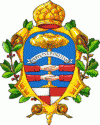Pesaro (Provincia di Pesaro e Urbino)
 |
Local industries include fishing, furniture making and tourism.
In 2020 it absorbed the former comune of Monteciccardo, now a frazione of Pesaro.
The city was established as Pisaurum by the Romans in 184 BC as a colony in the territory of the Picentes, the people who lived along the northeast coast during the Iron Age. In 1737, fourteen ancient votive stones were unearthed in a local farm field, each bearing the inscription of a Roman god; these were written in a pre-Etruscan script, indicating a much earlier occupation of the area than the 184 BC Picentes colony.
A settlement of the Picentes tribe has been found at Novilara. The northern Picentes were invaded in the 4th century BC by the Gallic Senones, earlier by the Etruscans, and when the Romans reached the area the population was an ethnic mixture. The Roman separated and expelled the Gauls from the country.
Under the Roman administration Pesaro, a hub across the Via Flaminia, became an important centre of trading and craftmanship. After the fall of the Western Empire, Pesaro was occupied by the Ostrogoths, and destroyed by Vitigis (539) in the course of the Gothic War. Hastily rebuilt five years later after the Byzantine reconquest, it formed the so-called Pentapolis, part of the Exarchate of Ravenna. After the Lombard and Frankish conquests of that city, Pesaro became part of the Papal States.
During the Renaissance it was ruled successively by the houses of Montefeltro (1285–1445), Sforza (1445–1512) and Della Rovere (1513–1631). Under the last family, who selected it as capital of their duchy, Pesaro saw its most flourishing age, with the construction of numerous public and private palaces, and the erection of a new line of walls (the Mura Roveresche). In 1475, a legendary wedding took place in Pesaro, when Costanzo Sforza and Camilla d'Aragona married.
On 11 September 1860 Piedmontese troops entered the city, and Pesaro was subsequently annexed to the new Kingdom of Italy (see also Battle of Castelfidardo).
Map - Pesaro (Provincia di Pesaro e Urbino)
Map
Country - Italy
 |
 |
| Flag of Italy | |
Italy was the native place of many civilizations such as the Italic peoples and the Etruscans, while due to its central geographic location in Southern Europe and the Mediterranean, the country has also historically been home to myriad peoples and cultures, who immigrated to the peninsula throughout history. The Latins, native of central Italy, formed the Roman Kingdom in the 8th century BC, which eventually became a republic with a government of the Senate and the People. The Roman Republic initially conquered and assimilated its neighbours on the Italian peninsula, eventually expanding and conquering a large part of Europe, North Africa and Western Asia. By the first century BC, the Roman Empire emerged as the dominant power in the Mediterranean Basin and became a leading cultural, political and religious centre, inaugurating the Pax Romana, a period of more than 200 years during which Italy's law, technology, economy, art, and literature developed.
Currency / Language
| ISO | Currency | Symbol | Significant figures |
|---|---|---|---|
| EUR | Euro | € | 2 |
| ISO | Language |
|---|---|
| CA | Catalan language |
| CO | Corsican language |
| FR | French language |
| DE | German language |
| IT | Italian language |
| SC | Sardinian language |
| SL | Slovene language |



































